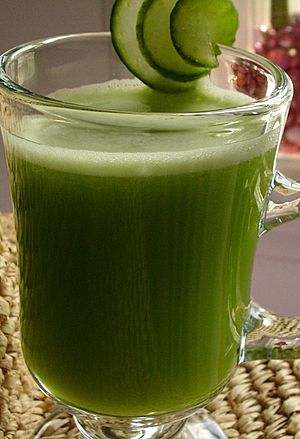Vegetable juice facts for kids
Vegetable juice is a drink mostly made from blended vegetables. You can also find it as a powder. People often mix vegetable juice with fruits like apples or grapes to make it taste better. It's sometimes seen as a healthier choice than fruit juice because it can have less sugar. However, some store-bought vegetable juices use fruit juices to sweeten them. They might also have a lot of sodium, which is salt.
Contents
Making Your Own Vegetable Juice
You can make vegetable juice at home instead of buying it. This can help you get more vegetables and fruits into your diet. A special machine called a juicer separates the juice from the plant fibers.
There are different kinds of juicers:
- Slow juicers (also called masticating juicers) grind the vegetables slowly. This gentle process is thought to protect nutrients from heat and air.
- Fast juicers use centrifugal force (spinning very fast) to get the juice out quickly.
Some people believe that slow juicers keep more good things, like enzymes, in the juice. Making juice from tiny leaves like wheatgrass often needs a slow juicer.
Different Kinds of Vegetable Juices

Many store-bought vegetable juices mix different vegetables. Common ones include carrots, beets, pumpkin, and tomatoes. Even though tomatoes and pumpkins are technically fruits, they are often used in vegetable juices to improve the taste.
Other popular vegetables used in juices are:
Sometimes, people add lemon, garlic, or ginger to their juices. They might do this for health reasons.
Some juices are made mostly from one vegetable, like carrot juice or tomato juice. Turnip juice is also a type of vegetable juice.
In some parts of Asia, especially China, a plant called Chinese yam is used in vegetable juices. It's used sparingly because many Chinese people see it more as a medicine than a vegetable.
In Japan, kale juice called Aojiru is well-known. People drink it for its health benefits, even though it can taste bitter. Japanese vegetable juices often use carrots and fruits for flavor, rather than a lot of tomato juice like Western ones.
How Nutritious is Vegetable Juice?
Vegetable juices are usually seen as a way to add to your diet, not to replace whole vegetables. However, how much nutrition juices offer compared to whole vegetables is still a topic of discussion.
The USDA says that three-quarters of a cup of 100% vegetable juice counts as one serving of vegetables. A study from 2006 suggested that juices might offer similar health benefits to whole vegetables. This includes possibly lowering the risk of cardiovascular disease (heart problems) and cancer. Another study found that drinking vegetable juice could lower the risk of Alzheimer's disease by 76%.
However, some experts, like the British Nutrition Foundation, say that no matter how much vegetable juice you drink, it only counts as one serving of vegetables. A Japanese study in 2007 also found that while commercial Japanese juices had some good nutrients, they weren't enough to be your main source of vegetables.
Some popular vegetable juices, especially those with a lot of tomato, can be high in sodium (salt). So, it's good to be careful about how much you drink if you're watching your salt intake. Some vegetables, like beets, also have a lot of natural sugar.
Certain vegetable juices can also add a lot of oxalate to your diet. If someone tends to form kidney stones made of calcium oxalate, they might be told to limit these juices. There have been cases where too much oxalate from juices caused kidney problems in people who were sensitive to it.
Even with some debates about their exact nutritional benefits, a study from UC Davis in 2008 found something interesting. It showed that people who drank vegetable juice daily were more likely to eat the recommended amount of vegetables. Having an easy source of vegetables seemed to encourage them to add more veggies to their meals. For children who don't like eating whole vegetables, vegetable juice mixed with fruit juice can be a tasty way to get some nutrients.
See also
 In Spanish: Jugo de verduras para niños
In Spanish: Jugo de verduras para niños


